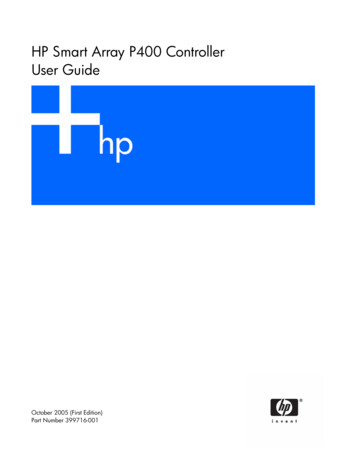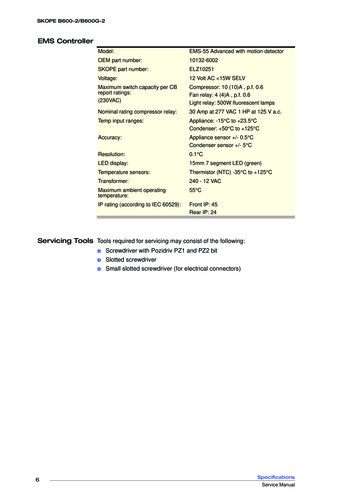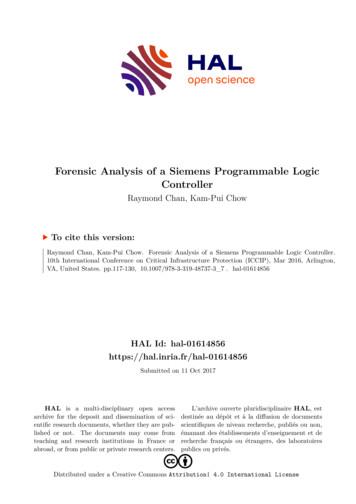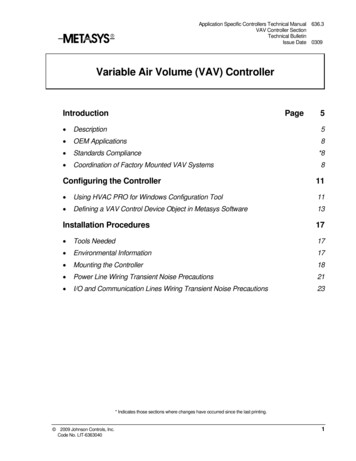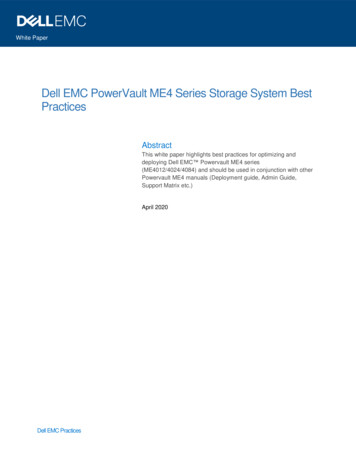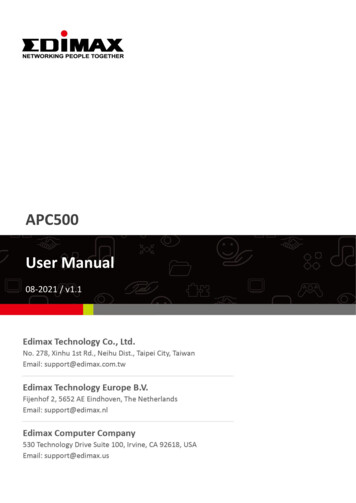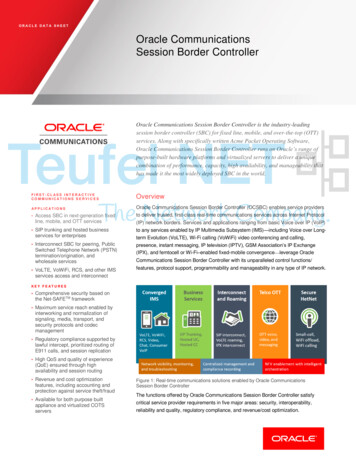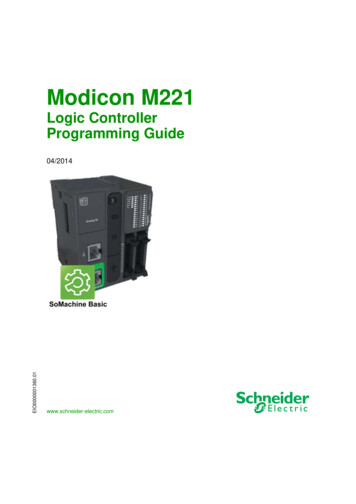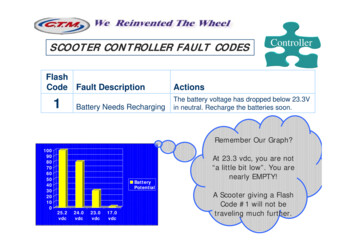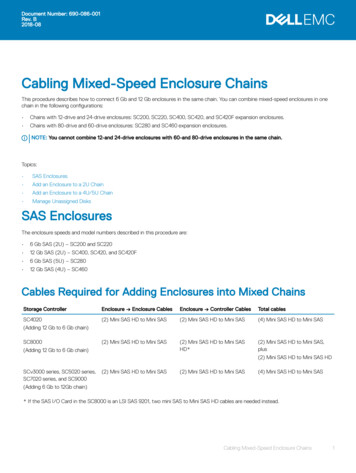![NC Controller 4-30-2014.pptx [Read-Only]](/img/31/pci-dss-security-awareness-training-ryan.jpg)
Transcription
5/1/2014PCI DSS Security Awareness TrainingNorth Carolina Office of the State Controller – Technology MeetingApril 30, 2014agio.comA Note on Our New NameSecure Enterprise Computing was acquired as the Security Division ofAgio LLC in March 2013. As part of our one-year anniversary with Agio(the superior provider of managed IT services for the world’s premieralternative investment managers) we’re fully adopting the Agio brand.We will continue serving our clients across the financial, government,healthcare, education, commercial, retail and hospitality markets, andnow we have the capability to offer a rich portfolio of IT servicessolutions. As the market continues to seek integrated, single-point-ofcontact providers, this augmentation to our business ensures ourclients remain ahead of the curve.Same great people, same great service, but now with so much more 11
5/1/2014Agio - What We DoOur Security Credentials 20 years of continuous service as IT SecurityConsultants and Security VAR 15 years conducting compliance-based assessments PCI Qualified Security Assessor (QSA) since 2009 PCI Approved Scanning Vendor (ASV) since 2006 HITRUST (HIPAA/HITECH) Certified Practitioners 1 of 9 companies pre-approved by State of NC toconduct assessments for state agencies and highereducation Consultants hold many certifications including CISSP,SANS, etc. and have on average 15 years of experience2
5/1/2014PCI Introduction and HistoryPCI Security Standards Council Historical Data PCI DSS created in December 2004 Original Compliance Deadline was June 2005 PCI SSC formed in Sept of 2006 and Version 1.1 of the standardreleased Version 1.2 released October of 2008 Version 2.0 released October 2010 – Currently in use Version 3.0 released October 2013 – Goes into effect January 1,2015 (can be used now)53
5/1/2014The Payment Card Industry Data Security Standard (PCIDSS)What is PCI-DSS?1. It is a private initiative set forth bythe Payment Card Industry.2. A set of standards outlining howsensitive data is handled bothoperationally and technically.6The Payment Card Industry Data Security Standard (PCIDSS)3. PCI DSS provides protections forall participants in a credit cardtransaction.4. Applies to anyone who “stores,transmits, or processes”cardholder data.5. Applies to both physical andelectronic data, including but notlimited to: servers, removablemedia, backup media, anddocuments.74
5/1/2014PCI: What Does It Protect? The primary account number is the defining factor in theapplicability of PCI DSS requirements. PCI DSS requirements are applicable if a primary account number(PAN) is stored, processed, or transmitted. If PAN is not stored,processed, or transmitted, PCI DSS requirements do not apply. PCI DSS applies wherever account data is stored, processed ortransmitted. Account Data consists of Cardholder Data plusSensitive Authentication Data.8PCI eportFeedbackGuidance and Enforcement – The Different RolesMerchants95
5/1/2014PCI: What Can Be Stored and How?Data imary AccountNumber (PAN)StoragePermitted?Render Stored AccountDataUnreadableYesYesCardholder NameYesNoService CodeYesNoExpiration DateYesNoFull Magnetic StripeDataNoCannot store afterauthorizationCAV2/CVC2/CVV2/CIDNoPIN/PIN BlockNoCannot store afterauthorizationCannot store afterauthorization10Cardholder Data116
5/1/2014PCI DSS Is Not Law Through your Merchant Agreement with your acquiring bank, youare contractually bound to abide by all relevant PCI standards No threat of incarceration for non-compliance with PCI DSSSecurity Breach Notification Laws– See N.C. Gen. Stat § 75-65 which identifies cardholder data asPersonally Identifiable Data (PII) which is protected under NorthCarolina law12Possible Fines for Non-compliance First ViolationUp to 50,000 Second ViolationUp to 100,000 Third ViolationUp to Management Discretion Failure to Report aCompromiseUp to 100,000 Egregious ViolationUp to 500,000 Level 1 Merchant (6,000,000 transactions per year)Up to 100,000AND If not compliant after 60 days, MasterCard or Visaadditional fines of 10,000 per day(not to exceed 500,000 per year) Level 2 Merchant (150,000–6,000,000 transactions per year)Up to 50,000AND If not compliant after 60 days, MasterCard or Visaadditional fines of 10,000 per day(not to exceed 500,000 per year) Level 3 Merchant (20,000–150,000 transactions per year)Up to 25,000AND If not compliant after 60 days, MasterCard or Visaadditional fines of 10,000 per day(not to exceed 500,000 per year)137
5/1/2014PCI: Technical and Operational on DetectionSecurity Awareness TrainingTwo-factor AuthenticationIncident Response TestingAntivirusChange ControlEncryptionEmployee ScreeningSecurity Event LoggingRisk Assessment14PCI DSS: 6 Goals with 12 RequirementsBuild and MaintainA Secure Network1. Install and maintain a firewall configuration to protect data2. Do not use vendor supplied defaults for system passwords and othersecurity parametersProtect Cardholder Data3. Protect stored data4. Encrypt transmission of cardholder data and sensitive informationacross public networksMaintain A VulnerabilityManagement Program5. Use and regularly update antivirus software6. Develop and maintain secure systems and applicationsImplement Strong AccessControl Measures7. Restrict access to data by business need‐to‐know8. Assign a unique ID to each person with computer access9. Restrict physical access to cardholder dataRegularly Monitorand Test Networks10. Track and monitor all access to network resources and cardholderdata11. Regularly test security systems and processesMaintain an InformationSecurity Policy12. Maintain a policy that addresses information security158
5/1/2014Payment Brand Compliance Programs Each payment brand develops and maintains its ownPCI DSS compliance programs in accordance with itsown security risk management policies– American Express: Data Security Operating Policy(DSOP)– Discover: Discover Information Security Compliance(DISC)– JCB: Data Security Program– MasterCard: Site Data Protection (SDP)– Visa USA: Cardholder Information Security Program(CISP)– Other Visa Regions: Account Information Security (AIS)16ProgramPCI Merchant LevelsMerchantLevelMerchant DefinitionComplianceLevel 1More than 6 million V/MC transactionsannually across all channels, includingeCommerceAnnual On-site PCI DataSecurity Assessment andQuarterly Network ScansLevel 21,000,000 – 5,999,999 V/MCtransactions annuallyAnnual Self-Assessmentand Quarterly NetworkScansLevel 320,000 – 1,000,000 V/MC eCommercetransactions annuallyAnnual Self-Assessmentand Quarterly NetworkScansLevel 4Less than 20,000 V/MC eCommerceAnnual Self-Assessmenttransactions annually, and all merchants and Annual Network Scansacross channel up to 1,000,000 VISAtransactions annually179
5/1/2014Self Assessment Questionnaire (SAQ) 9 different SAQ’s (3 additional since v 2.0)– Binary standard: “in place” or “not in place”– What is your bank/processor asking for? Qualifiers/Disqualifiers– Electronic storage of CHD (just because you don’t store CHD doesn’tnecessarily mean you don’t have to use SAQ D)– Read the “Before You Begin” section18Self Assessment Questionnaire (SAQ) (Cont’d) A: Card-not-present Merchants, All CHD functions fully outsourced– “Completely outsourced to “validated” third parties A-EP: Partially Outsourced E-commerce Merchants using thirdparty Website for Payment Processing– Your e-commerce website does not receive CHD but controls howconsumers, or their CHD, are redirected to a validated third-partyprocessor B: Imprint Machines or Standalone dial-out terminals B-IP: IP connected PTS Point-of-interaction (POI) terminals1910
5/1/2014Self Assessment Questionnaire (SAQ) (Cont’d) C: Payment applications connected to the Internet, No CHDstorage– POS directly connected to the Internet– Not connected to any other systems in the environment C-VT: Web-based Virtual Payment Terminals, No CHD storage– Manually enter a single transaction at one time– Terminal solution is provided and hosted by a validated third-partyprocessor– No card readers attached– Organization does not transmit CHD through any other channels20Self Assessment Questionnaire (SAQ) (Cont’d) P2PE-HW: Hardware Payment Terminals in a PCI-Listed P2PESolution, No CHD– The implemented solution is listed on the PCI SSC’s list of “validated”Point-to-Point Encryption solutions D: All other SAQ-Eligible Merchants– Network D D: SAQ-Eligible Service Providers2111
5/1/2014Common PCI DSS Violations Storage of magnetic stripe data (Requirement 3.2). It is important to note thatmany compromised entities are unaware that their systems are storing thisdata. Inadequate access controls due to improperly installed merchant POSsystems, allowing malicious users in via paths intended for POS vendors(Requirements 7.1, 7.2, 8.2 and 8.3) Default system settings and passwords not changed when system was set up(Requirement 2.1) Unnecessary and insecure services not removed or secured when system wasset up (Requirements 2.2.2 and 2.2.4) Poorly coded web applications resulting in SQL injection and othervulnerabilities, which allow access to the database storing cardholder datadirectly from the web site (Requirement 6.5); redirect from website Missing and outdated security patches (Requirement 6.1)22Common PCI DSS Violations (Cont’d) Lack of logging (Requirement 10) Lack of monitoring (via log reviews, intrusion detection/prevention, quarterlyvulnerability scans, and file integrity monitoring systems) (Requirements 10.6,11.2, 11.4 and 11.5) Poorly implemented network segmentation resulting in the cardholder dataenvironment being unknowingly exposed to weaknesses in other parts of thenetwork that have not been secured according to PCI DSS (for example, fromunsecured wireless access points and vulnerabilities introduced via employeee-mail and web browsing) (Requirements 1.2, 1.3 and 1.4)2312
5/1/2014What Should I Do? Identify all payment channels (methods of processing payment)– Group the Merchant IDs MIDs– Location– Applications– Storage Identify all systems used in the process (scoping)– Asset inventory Conduct gap assessment– Apply the standard to the “in scope” systems24PCI CompliancePCI-DSS is NOT merely about checking boxesThe intent of PCI-DSS is toprevent fraud and protectcustomers. Requirementsmust be met, but the goal isto provide robustinformation security withinyour organization.2513
5/1/2014PCI 3.0 UpdateThe PCI DSS Lifecycle The PCI DSS follows a three-year lifecycle PCI DSS 3.0 was released in October 2013 Optional (but recommended) in 2014; Required in 2015Lifecycle for Changes to PCI DSS and PA-DSS18StandardsPublishedOctoberFinalReview2May ‐ JulyStandardsEffectiveJanuary sNovember ‐ ReviewApril ‐ AugustAll YearCOMMUNITYMEETINGSeptember‐OctoberYEAR 25MarketImplementationOld StandardsRetiredDecember 314FeedbackBeginsNovember2714
5/1/2014Key Themes Education and awareness Flexibility and consistency Security as a shared responsibility Emerging threats28Best Practices for Implementing PCI DSS Into Business AsUsual (BAU) Processes Continuous compliance with due diligence needed PCI DSS is not a “once-a-year” activity Don’t forget about the people and processes2915
5/1/2014Administrative Improvements Enhanced sampling examples and testing procedures for eachrequirement Enhanced reporting guidance– Navigation Guide integrated into PCI DSS v 3.0 New templates (ROC/SAQ)– ROC reporting instructions built into the ROC template– Easier to complete, more concise– Visual queues for when diagrams are needed Policy and procedure requirements moved from Section 12 to eachindividual section30Administrative Improvements (Cont’d) Added flexibility to meet requirements:– Passwords– Web application firewalls– File integrity monitoring (FIM)– Inventory/labeling options NEW requirements listed in this presentation are either arequirement as of January 1, 2015 or a best practice until June 30,2015, after which they become mandatory requirements (see list). Note: Cannot mix and match v 2.0 and v 3.0 in 2014 – must useone or the other this year3116
5/1/2014Scoping Guidance Improper scoping leads to increased risk– Look at people and process Focus on security, rather than compliance Not a one-time-a-year activity Confirm effectiveness of PCI scope (penetration test) Goal: reduce complexity and create more efficient security Risk assessments as scoping aid32Clarifications for Segmentation Isolation is clarified Controlled access means a connection exists, therefore thosesystems are in scope (AD, AV, DNS, time servers, etc.) Improved language to verify effectiveness3317
5/1/2014Changes – Requirement 1“Build and Maintain a Secure Network and Systems”Clarifications:– Configuration standards must be documented and implemented (1.1.x)– Network diagram & CHD flows (1.1.2-1.1.3)– Insecure services, protocols, ports (1.1.6)– Securing router configuration files (1.2.2)– Wireless access control to CDE (1.2.3)– Anti-spoofing (1.3.4)– Access to CDE from untrusted networks (1.3.7)– Requirement and testing procedures (1.4)34Changes – Requirement 2“No Vendor Defaults”Clarifications:– Change all default passwords; remove unnecessary default accounts(2.1)– Change all wireless default passwords at installation (2.1.1)– Include the above in Configuration Standards (2.2)– Enable only necessary/secure services, protocols, and ports (2.2.22.2.3)3518
5/1/2014Changes – Requirement 2“No Vendor Defaults”NEW Requirement:– Maintain an inventory of all systems and components that are in scopefor PCI DSS36Changes – Requirement 3“Protect Stored Cardholder Data (CHD)”Clarifications:– Data Retention and Disposal (3.1.x)– Sensitive Authentication Data (SAD) proper destruction after authorization(3.2)– Primary Account Number (PAN) masking (3.3)– Separation of OS and Disk-level encryption authentication mechanisms(3.4.1)– Key Management procedures (3.5)– Provided flexibility with more options for secure storage of cryptographickeys (3.5.2-3.5.3)– Testing implementation of crypto key management (3.6.x)– Crypto key “split-knowledge” and “key control” (3.6.6)3719
5/1/2014Changes – Requirement 4“Encrypt Transmission of CHD Across UntrustedNetworks”Clarifications:– Expanded examples of open public networks (4.1)38Changes – Requirement 5“Maintain a Vulnerability Management Program”Clarifications:– Ensure all AV mechanisms are maintained properly (5.2)NEW Requirements:– Systems not commonly affected by malware must be evaluated (5.1.2)– Ensure AV is running and cannot be disabled/altered (5.3)3920
5/1/2014Changes – Requirement 6“Develop & Maintain Secure Systems and Applications”Clarifications:– Identifying, risk ranking, and patching critical vulnerabilities (6.1-6.2)– Written software development procedures (6.3)– Development and Test environments (6.3.1)– Enhanced testing procedures that include document reviews (6.4)– Enforce separation of production and development environments withaccess controls (6.4.1)– Updated list of current and emerging coding vulnerabilities and securecoding guidelines (6.5.x)– Options beyond Web Application Firewall provided (6.6)40Changes – Requirement 6“Develop & Maintain Secure Systems and Applications”NEW Requirements:– Handling of PAN and SAD in memory (6.5)– Coding practices to protect against broken authentication and sessionmanagement (6.5.10)4121
5/1/2014Changes – Requirement 7“Restrict Access to CHD by Business Need-to-Know”Clarifications:– Revised testing procedures (7.1)– Definition of access needs for each role (7.1.1)– Restrict Privileged User IDs to least necessary (7.1.2)– Assign access based upon role/classification (7.1.3)42Changes – Requirement 8“Identify and Authenticate Access to System Components”Clarifications:– User identification (8.1)– Remote vendor access (8.1.5)– User authentication (8.2)– Changed passwords to passphrases/authentication credentials– Requirements apply to 3rd Party Vendors– Strong cryptography for authentication credentials (8.2.1)– Authenticate users prior to modifying credentials (8.2.2)4322
5/1/2014Changes – Requirement 8“Identify and Authenticate Access to System Components”Clarifications:– Requirements 8.1.1, 8.1.6-8.1.8, 8.2, 8.5, and 8.2.3-8.2.5 are notintended to apply to user accounts within a point-of-sale (POS)application that only has access to one card number at a time in orderto facilitate a single transaction (such as cashier accounts).– Two-factor authentication applies to users, administrators, and all thirdparties (8.3)– How to protect authentication credentials (8.4)44Changes – Requirement 8“Identify and Authenticate Access to System Components”NEW Requirements:– Options provided beyond passwords (tokens, smart cards, andcertificates) for equivalent variations (8.2.3)– Service Providers with access to customer environments must use aunique authentication credential (e.g., password) for each customerenvironment (8.5.1)– Physical security tokens must be capable of being linked to anindividual account (8.6)4523
5/1/2014Changes – Requirement 9“Restrict Physical Access to Cardholder Data”Clarifications:– Protection of network jacks (9.1.2)– Differentiation between on-site personnel and visitors – options madeavailable (9.2.x)– Visitor audit trails (9.4.x)46Changes – Requirement 9“Restrict Physical Access to Cardholder Data”NEW Requirements:– Control physical access to sensitive areas for on-site personnel (9.3)– Protect POS terminals and devices from tampering or substitution (9.9)4724
5/1/2014Changes – Requirement 10“Track and Monitor All Access to Network Resources and CardholderData”Clarifications:– Audit trails linked to individuals (10.1)– Clarified the intent and scope of daily log reviews (10.6)48Changes – Requirement 10“Track and Monitor All Access to Network Resources and CardholderData”NEW Requirements:– All changes to identification and authentication mechanisms and allchanges to root or administrator access must be logged (10.2.5)– Pausing, stopping, and restarting of audit logs must be logged (10.2.6)4925
5/1/2014Changes – Requirement 11“Regularly Test Security Systems and Processes”Clarifications:– Added guidance regarding multiple scan reports (11.2)– Quarterly internal vulnerability scans must be repeated until a passingscan results (11.2.2)– Internal and External scans must be performed after significantchanges (11.2.3)– Correct all vulnerabilities detected during a Penetration Test (11.3.3)– Methods expanded for detecting changes to files (11.5)50Changes – Requirement 11“Regularly Test Security Systems and Processes”NEW Requirements:– Have an inventory and business justification for wireless access points(11.1.x)– Implement a methodology for penetration testing, and performpenetration tests to verify that the segmentation methods areoperational and effective (11.3)– Develop process to respond to change detection alerts (11.5.1)5126
5/1/2014Changes – Requirement 12“Maintain a Policy that Addresses Security for allPersonnel”Clarifications:– Policy and procedure requirements moved from Section 12 to eachindividual section– Added options regarding identification (labeling) of devices (12.3.4)– Testing of remote access timeouts (12.3.8)– Management of Service Providers (12.8)– Further defined the components of Incident Response plan (12.10.x)52Changes – Requirement 12“Maintain a Policy that Addresses Security for allPersonnel”NEW Requirements:– Risk Assessment should be performed at least annually and aftersignificant changes (12.2)– Maintain separation of duties for security responsibilities (12.4.1)– Clarified essential components of Service Provider agreements(12.8.2)– Maintain information about which PCI DSS requirements are managedby service providers and which are managed by the entity (12.8.5).– Service providers to acknowledge responsibility for maintainingapplicable PCI DSS requirements. (12.9)5327
5/1/2014Next Steps – How to Prepare for 3.0 Review the clarifications to ensure compliance Verify effective segmentation of CDE Look at day-to-day PCI compliance efforts– Are configuration standards current?– Are diagrams current?– Are security procedures current and being followed? Review asset inventory process (2.x); ensure it includes all CDEsystems and any wireless access points (11.2) Consider AV options for increased coverage (5.1.2) Ensure AV is locked down (5.3)54Next Steps – How to Prepare for 3.0 (Cont’d) Ensure the Risk Ranking Procedure is documented and followed(6.2) Review PA DSS Implementation Guides– How is PAN/SAD stored in memory managed? (6.5.6) Review session management coding practices (6.5.11) Review how service providers are managed– Access management - no shared IDs/accounts (8.5.1)– Fully PCI compliant (12.8)– Review contracts, clearly define responsibilities (12.8.2)– Ensure the Service Provider acknowledges responsibilities (12.9)5528
5/1/2014Next Steps – How to Prepare for 3.0 (Cont’d) Review security tokens and ensure each is linked to a uniqueindividual (8.6) Review on-site personnel access controls to sensitive areas (9.3) Consider methods to prevent tampering with POS equipment (9.9) Review log security settings (admins, stop/start, etc.) (10.2.5-6) If wireless is used, document the business justification (11.1) Ensure penetration test methodology is documented (11.3) Ensure vulnerabilities detected are corrected and then retest toensure compliance for internal scans (11.2.2) and penetration tests(11.3.3)56Next Steps – How to Prepare for 3.0 (Cont’d) Ensure security alerts (FIM/IDS/etc.) are integrated into incidentresponse process (11.5.1) Verify that remote access timeouts are working properly (12.3.8) Verify that risk assessments are performed both annually and aftersignificant changes to CDE are made (12.2) Ensure separation of duties exists for information security (12.4.1) Review and update the incident response plan (12.10)5729
5/1/2014Questions?PCI Security Awareness TrainingThank you!Agio has performed network and application security assessments for over 14years. Agio is recognized by the Payment Card Industry Security StandardsCouncil (PCI SSC) as both a Qualified Security Assessor (QSA) and an ApprovedScanning Vendor (ASV).We are happy to help you with any and all compliance efforts.919 380 7979Agio agio.com/security5930
5/1/2014Contact UsSherry WorthingtonAccount Managersherry.worthington@agio.comLaurie LeighDirector of Saleslaurie.leigh@agio.comAgio909 Aviation Parkway, Suite 600Morrisville, NC 27560phone 919 380 7979fax919 380 9055webwww.agio.com/securityShawn RyanSenior Security Engineer and LeadQSA6031
vulnerability scans, and file integrity monitoring systems) (Requirements 10.6, 11.2, 11.4 and 11.5) Poorly implemented network segmentation resulting in the cardholder data environment being unknowingly exposed to weaknesses in other parts of the network that have not been secured according to PCI DSS (for example, from
